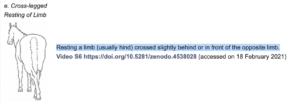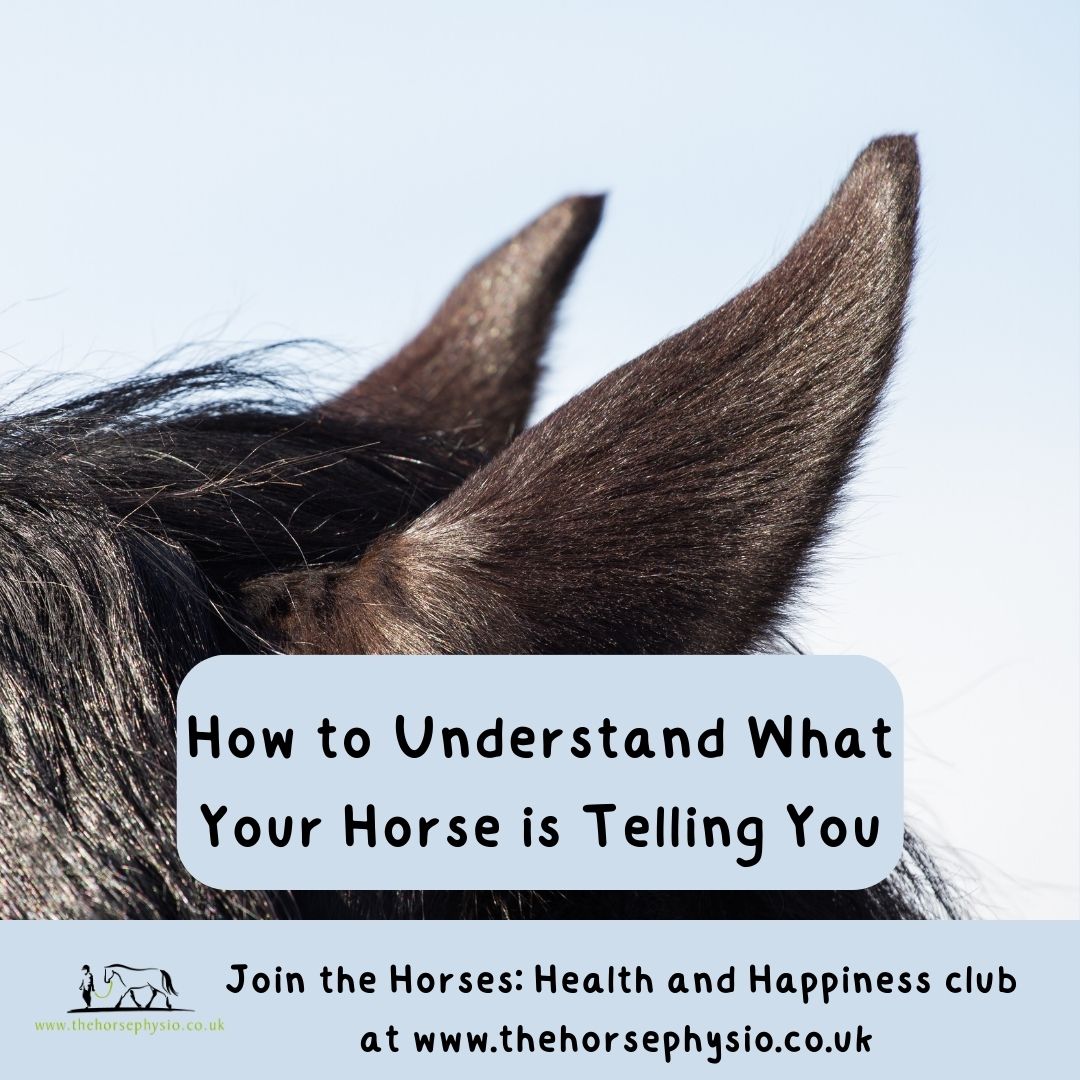“Everyone knows when something isn’t right with their horse, it’s easy to tell”. That’s what I heard when I was out with a group of people, several of whom I’d not met before. It was not the time to be putting my opinion out there, but I don’t agree with this perspective. I grew up with horses, and as I look back, I feel bad at how much I missed of what my horses were trying to tell me. I know that I will look back in ten years, and wish I knew now what I will know then about how horses communicate. Even when we do our best to understand what our horse is telling us, I suspect we could know more.
I remember a friend telling me that they didn’t need to do baby signing with their firstborn because they already knew exactly what their baby was trying to tell them. Maybe I just doubt myself more than most, but for me, that couldn’t have been further from the truth. With my son, I was often trying to figure out what it was that he needed. I remember phoning my mum one time when my son just wouldn’t stop screaming, and she could tell over the phone that he was hungry. She was right, but I hadn’t been able to understand his needs – whether because it was all too new to me (my son was only a couple of weeks old), or because I was too tired, or maybe I just wasn’t good at it! I know that if I’d had a second child, it would have been easier to interpret baby language, but I suspect I would still always have felt that there was room for improvement.
With a baby, we’re typically with them almost 24/7, so there is a lot of opportunity to learn. With our horses, we generally only see them for a relatively short period of the day. So, why would we expect to understand their language accurately? What makes us think that we can interpret the signals of another species without any training? How do we know if we’re right or wrong?
My experience as an ACPAT and RAMP registered Chartered Physiotherapist tells me that there are many cases where an owner can misinterpret the language that their horse is using to communicate pain. I honestly believe that many horses enjoy their work, and their time with humans. But I also believe there are many who are trying to say that they are hurting, and who are being ignored. No one deliberately ignores their horse. Everyone I know loves their horse (it’s not like it’s a cheap hobby if you don’t love your horse and your time with him!), and wants the best for him. It’s simply that we don’t know what we don’t know. We are all doing the best we can with the tools, knowledge, and experience that we have available to us. As we gain knowledge, tools, and experience, we will do better. Which means that we need to keep learning.
One of the horses I’m treating, let’s call her Copper, belongs to a Chartered Physiotherapist who works in the human field rather than the animal field. Copper is variable in her attitude towards being around people. Some days she is all sweetness and light, other days her ears are flat back, and she clearly does not want you in her space. Her ridden work is also variable, with some days better than others. Using the Ridden Horse Pain Ethogram, Copper’s owner recognised that she showed some of the signs that suggest musculoskeletal pain, and she was investigated by the vets. She had treatment, and her ridden work has improved greatly, but somehow things still aren’t quite as good as they could be. Because I am learning all the time, my approach to treating her has adjusted over the years. At this stage, the vets do not feel that there is a need for further veterinary treatment, and therefore we are working to help her through physio. Luckily for Copper, as a physio herself, her owner understands more than most how and why the exercises I recommend are so important. She can carry the exercises out with skill because she can translate the work that she does with people into treating her horse. I feel as though we are finally getting to the root cause of Copper’s stiffness and restrictions. I explained to Copper’s owner that I often use my intuition, guided by a solid background of knowledge and experience, but that I can’t provide her with any scientific evidence or diagnostics to explain why I’m taking the approach that I am with the treatment. As a physio with many years of experience, she understands, and she agreed with me on the importance of intuition.
As I said, my intuition in relation to assessing and treating horses is based on many years of education, both as a physio and as a horse person. Yet, I still (constantly!) feel as though I don’t know enough. I’m continually on the lookout for new information, and new learning, to help me to get closer to ’right’. The Ridden Horse Pain Ethogram is a massive step forward, and co-authoring a book on the subject with Dr Sue Dyson allowed me to be immersed in the subject of recognising pain in the ridden horse for over a year. Our book, ‘Harmonious Horsemanship: Use of the Ridden Horse Ethogram to Optimise Potential, Partnership, and Performance’ is due at the end of June 2023. You can join my mailing list to be kept up to date with news of the book.
A study published in 2021 looked at the signs of pain behaviour in horses at a veterinary referral clinic. The Equine Discomfort Ethogram study was published in the journal ‘Animals’ and is freely available on the internet. Below is the study’s summary:
Simple Summary
Pain and discomfort behavior in horses tends to be especially subtle, and not readily or widely appreciated even by equine professionals, including many long-time horse keepers, trainers, and even by veterinarians, veterinary technicians, and care staff. Based on decades of evaluating the behavior of normal and physically uncomfortable horses in a referral hospital, as well as research context, we describe and illustrate a catalog of behaviors (ethogram) associated with equine physical discomfort. Our objective is to promote an unambiguous universal understanding of equine discomfort behaviors associated with various body systems and anatomic sources.
Citation: Equine Discomfort Ethogram, Torcivia, C.; McDonnell, S. Equine Discomfort Ethogram. Animals 2021, 11, 580. https://doi.org/10.3390/ani11020580
The Equine Discomfort Ethogram is a list of 73 behaviours, each described clearly, and with a line drawing to illustrate it. The behaviours are related to horses standing in the stable or field, rather than the ridden behaviours in the Ridden Horse Pain Ethogram. There are also links to video recordings for each behaviour. As mentioned in the study; “The resulting list of equine discomfort behaviors in this ethogram includes a total of 64 specific discomfort behaviors grouped into eight categories: posture and weight-bearing; limb and body movements; head, neck, mouth, and lip movements; attention to area; ear and tail movements; overall demeanor; altered eating or drinking; and vocalizations/audible sounds. Some behaviors have slight variations in form (e.g., stretching), resulting in a total of 73 entries”. In the article, you will find links to a table for each group of behaviours.
This is a lot of behaviours to take in and get your head around, and some of them are only related to horses in a hospital situation. Some of them are blatantly obvious. For example, if you saw your horse holding one leg up and refusing to put his weight through it, you’d probably recognise pretty quickly that something was wrong (Table 1, behaviour h: Flexing and hanging a limb above the substrate for several seconds or longer, often in a series, momentarily resting the toe lightly on the substrate between lifts). But how about if he’s just resting one hindleg? (Table 1, behaviour e: Resting a limb (usually hind) crossed slightly behind or in front of the opposite limb).

Figure 1: (Screenshot) Table 1, behaviour e: Resting a limb (usually hind) crossed slightly behind or in front of the opposite limb
There are some behaviours that all of us would realise meant our horse was in pain. But there are others that many of us would think of as ‘normal’ for some horses. I think that, as with all scientific research, the information provided needs to be taken in context. If you have a look through the behaviours and recognise some in your horse, have a chat with some people on your horse’s support team, and get their take on it. In particular, your yard owner, coach, vet, farrier, and physical therapist would be good people to talk to. If you don’t have a physical therapist involved with your horse, then in the UK you can find a Chartered Physiotherapist at www.acpat.org, and a Registered Animal Musculoskeletal Practitioner at www.rampregister.org.
I understand how much you love your horse and how much you want to get things right for him. The last thing you want is for him to be uncomfortable. This is why it’s so important that you take the time to educate yourself on the signs of pain and discomfort in the horse. The evidence in this area is growing fast, and I’m hoping to be able to share much more with you over the coming years. This will not only help you as an owner, but it will also improve my practice as a horse physio.
Sue Palmer, aka The Horse Physio, is an award-winning ACPAT and RAMP registered Chartered Physiotherapist, an Intelligent Horsemanship Recommended Trainer, and holds an M.Sc. Formerly a competitive rider and BHSAI, she works full-time treating horses. Through multiple books and articles, Sue shares with you her passion for ethical and harmonious horsemanship.
Keep an eye out for my next book, “Harmonious Horsemanship: How to use the Ridden Horse Ethogram to Optimise Potential, Partnership, and Performance”. This ground-breaking book is co-authored with Dr Sue Dyson, and will be available in summer 2023. Sign up at www.harmonioushorsemanship.co.uk to be kept up to date with new information as it comes available. Meanwhile, you can find out more about the Ridden Horse Ethogram here.
Other books by Sue Palmer M.Sc. MCSP:
‘Horse Massage for Horse Owners’
